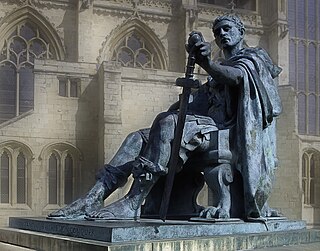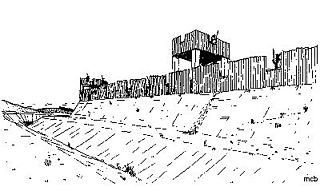
Lucius Septimius Severus was a Roman politician who served as emperor from 193 to 211. He was born in Leptis Magna in the Roman province of Africa. As a young man he advanced through the customary succession of offices under the reigns of Marcus Aurelius and Commodus. Severus was the final contender to seize power after the death of the emperor Pertinax in 193 during the Year of the Five Emperors.

Gaius Pescennius Niger was a Roman usurper from 193 to 194 during the Year of the Five Emperors. He claimed the imperial throne in response to the murder of Pertinax and the elevation of Didius Julianus, but was defeated by a rival claimant, Septimius Severus, and killed while attempting to flee from Antioch.

Legio XII Fulminata, also known as Paterna, Victrix, Antiqua, Certa Constans, and Galliena, was a legion of the Imperial Roman army. It was originally levied by Julius Caesar in 58 BC, and the legion accompanied him during the Gallic Wars until 49 BC. The unit was still guarding the Euphrates River crossing near Melitene at the beginning of the 5th century.

Legio IV Scythica, also written as Legio IIII Scythica, was a legion of the Imperial Roman army founded in c. 42 BC by the Roman general Mark Antony, for his campaign against the Parthian Empire, hence its other cognomen, Parthica. The legion was still active in the Roman province of Syria in the early 5th century.

Legio IX Hispana, also written as Legio VIIII Hispana, was a legion of the Imperial Roman army that existed from the 1st century BC until at least AD 120. The legion fought in various provinces of the late Roman Republic and early Roman Empire. The nickname "Hispana" was gained when it was stationed in Hispania under Augustus. It was stationed in Britain following the Roman invasion in AD 43. The legion disappears from surviving Roman records after c. AD 120 and there is no extant account of what happened to it.

Legio VI Victrix was a legion of the Imperial Roman army founded in 41 BC by the general Octavian. It was the twin legion of VI Ferrata and perhaps held veterans of that legion, and some soldiers kept to the traditions of the Caesarian legion.

Eboracum was a fort and later a city in the Roman province of Britannia. In its prime it was the largest town in northern Britain and a provincial capital. The site remained occupied after the decline of the Western Roman Empire and ultimately developed into the present-day city of York, in North Yorkshire, England.

Britannia Superior was a province of Roman Britain created after the civil war between Septimius Severus and Clodius Albinus. Although Herodian credits Severus with dividing Roman Britain into the Northern territory of Britannia Inferior and the Southern territory of Britannia Superior, modern scholarship argues that it is more likely that Caracalla was the person who made the split sometime in the early 3rd century CE. The previous British capital Londinium remained the centre of Britannia Superior while Eboracum, or modern York was the capital of Britannia Inferior. Epigraphical evidence shows that Upper Britain encompassed approximately what is now Wales, southern England and East Anglia. However, the official boundary between Britannia Superior and Inferior is still unclear.

Britannia Inferior was a new province carved out of Roman Britain probably around AD 197 during the reforms of Septimius Severus although the division may have occurred later, between 211 and 220, under Caracalla. The removal of the governors in Londinium from control over the legions guarding Hadrian's Wall was aimed at reducing their power, given Clodius Albinus's recent bid to become emperor. The province was probably formalised around 214 by Severus's son Caracalla.

Roman Syria was an early Roman province annexed to the Roman Republic in 64 BC by Pompey in the Third Mithridatic War following the defeat of King of Armenia Tigranes the Great, who had become the protector of the Hellenistic kingdom of Syria.

Pons Aelius, or Newcastle Roman Fort, was an auxiliary castra and small Roman settlement on Hadrian's Wall in the Roman province of Britannia Inferior, situated on the north bank of the River Tyne close to the centre of present-day Newcastle upon Tyne, and occupied between the 2nd and 4th centuries AD.

Concangis was an auxiliary castra in the Roman province of Lower Britain. Its ruins are located in Chester-le-Street, Durham, in England, and are now known as Chester-le-Street Roman Fort. It is situated 6 miles (10 km) north of Durham and 8 miles (13 km) south of Newcastle upon Tyne.
Legio VI Hispana may have been a legion of the Imperial Roman army. Only a few records attesting a "VI Hispana" were known in 2015. Seyrig (1923) argued that this unit was created in AD 68 and disappeared before 197. Another theory is that VI Hispana was created after 197 and was destroyed in the turmoil of the Empire's Third Century Crisis.
The gens Septimia was a minor plebeian family at ancient Rome. The gens first appears in history towards the close of the Republic, and they did not achieve much importance until the latter half of the second century, when Lucius Septimius Severus obtained the imperial dignity.

Gaius Julius Sohaemus was a Roman client king of Armenia.

Marcus Sedatius Severianus was a Roman senator, suffect consul, and general during the 2nd century AD, originally from Gaul. Severianus was a provincial governor and later a provincial consul. The peak of his career was as suffect consul for the nundinium of July–September 153 as the colleague of Publius Septimius Aper. He was governor of Cappadocia at the start of the Roman war with Parthia, during which he was convinced by the untrustworthy oracle to invade Armenia in 161. Sedatius committed suicide while under siege in the Armenian city of Elegeia, on the upper Euphrates. The legion he led was wiped out shortly after. He was replaced as governor of Cappadocia by Marcus Statius Priscus.
The gens Ovinia was a plebeian family at Rome. Members of this gens occur in history toward the end of the Republic, and from then to at least the fourth century. They produced generations of Roman senators, with Gaius Ovinius Tertullus obtaining the consulship toward the end of the second century.

This article lists historical events that occurred between 201–300 in modern-day Lebanon or regarding its people.

This article lists historical events that occurred between 101–200 in modern-day Lebanon or regarding its people.












